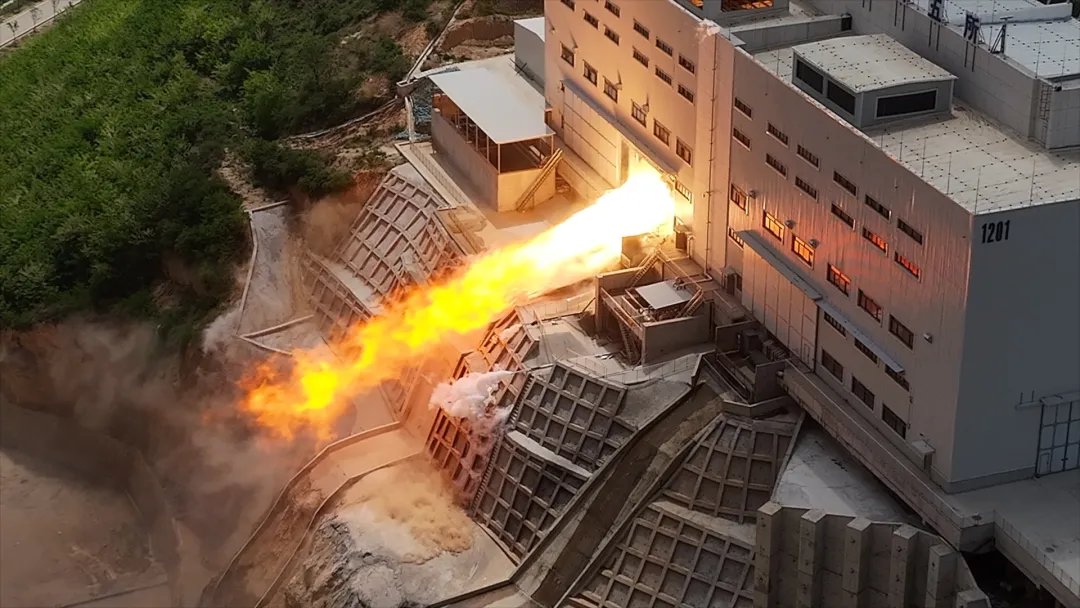China’s most powerful rocket engine for its space program’s Long March series of launch vehicles is now ready. The country concluded “ignition testing” on the ground, validating many of its systems, components, and core performance characteristics. According to the aerospace authority, the engine is now scheduled to transition for flight tests.
The China Aerospace Science and Technology Corporation (CASC) has said that the four “parallel liquid oxygen kerosene (kerolox) engines” underwent tests on April 28 at the Tongchuan Test Center in northwestern China’s Shaanxi province.
The liquid propellant/fuel engine is considered a technically and engineeringly complex endeavor owing to the instability and dangers surrounding handling and storing non-solid propellants. However, they allow controlling the rate of burn. Solid fuel engines, on the other hand, are more stable but do not allow modulating the rate of burn.
Next-Gen Rocket Engines
According to a report, Chief Designer Li Bin, from the CASC-affiliated Academy of Aerospace Propulsion Technology in Xian, said Sunday’s test “fully verified” the engines’ compatibility and individual reliability.
He told state broadcaster CCTV on Monday that the new engine is now ready to move to the flight test phase.
The YF-100K engines, each producing 130 tonnes of thrust, were designed with pump-back swing technology, significantly reducing the engine structures’ size and weight compared to the traditional front pump swing design.
“Engines built with the pump-back swing technology are typically more compact. For instance, we can fit four of them into a 3.8-meter-wide first-stage rocket and seven into a 5-meter-wide first-stage,” Li said.

The engines are the latest variant of the YF-100 kerolox engine, which powers the side boosters of China’s largest and most powerful launch vehicle, the Long March-5. While the CASC did not specify which rocket would be powered by the four parallel YF-100K engines, it said they would be used for a Long March model that would debut this year.
Long March 10 & 12 Launch Vehicles
This leaves the question of which of China’s space rockets the YF-100K will be installed on. In September 2023, CCTV said YF-100K engines would be used for Long March-10, the superheavy carrier rocket China is developing to put its astronauts on the Moon before 2030. It is expected to make its maiden flight in 2027.
The report said the Long March 10’s first-stage core and two boosters, at 920 meters (300 ft) high and with a diameter of 5 meters (16.40 ft), would each be powered by seven YF-100K engines to create an enormous 2,600 tonnes of thrust at lift-off.
The Long March-10 will be able to deliver 70 tonnes to Low Earth Orbit (LEO) and 27 tonnes into trans-lunar injection orbit, crucial for putting a spacecraft on a trajectory for a moon landing.
In February this year, CCTV reported that the two-stage Long March-12 – China’s first rocket with a 3.8-mt (12.46-ft) diameter – is expected to make its maiden flight in 2024 from one of the new commercial launch pads at the Wenchang spaceport in Hainan province.
The 59-mt (193-ft) Long March-12 will be a medium-lift launch vehicle capable of carrying a 10-ton payload to low Earth orbit and six tonnes to a 700-km (435 miles) sun-synchronous orbit.
Present ‘Strongest’ Rocket
China’s “strongest” rocket in existence before the Long March-12 has been identified as the Long March-5 by Global Times, which last operated on February 23 from the Wenchang Space Launch Site in South China’s Hainan Province.
It successfully sent the communication technology experiment-11 satellite into preset orbit.
This marked the seventh flight of “China’s strongest rocket model” and the 11th orbital launching flight of the Long March-5 family, which also includes a shorter variant, Long March-5B.
Developers China Academy of Launch Vehicle Technology (CALT) said that the class of rockets are poised to enter a “high-frequency launch period” over 2025 and 2026. In 2024 alone, the Long March-5 will see four launch missions, according to CALT’s deputy chief design engineer, Lou Luliang.
The Long March-5 has a 5-meter-diameter core stage, making it the “largest Chinese rocket in active service.” Its boosters are 3.35-mt in diameter. It made its maiden flight in 2016 and resumed flight operation on December 27, 2019.
In the following three years, the rocket successfully launched the Tianwen-1 Mars probe, the Chang’e-5 lunar probe, the China Space Station Tianhe core module, and the Wentian and Mengtian lab module into space.
China has also been making strides in manned spaceflight. On April 30, its Shenzhou 17 landed back with three taikonauts in China’s Inner Mongolia Autonomous Region after spending six months working on the Tiangong space station.
Prior to that, on April 25, the China Manned Space Agency launched a three-member crew to its orbiting space station. The agency aims to put astronauts on the Moon by 2030.
- The author can be reached at satamp@gmail.com
- Follow EurAsian Times on Google News